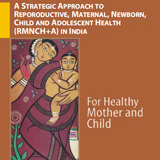
The purpose of this document is to provide the Health Secretaries, Mission Directors and Programme Managers at National and State level
Improving the maternal and child health and their survival are central to the achievement of national health goals under the National Rural Health Mission (NRHM) as well as the Millennium Development Goals (MDG) 4 and 5. In the past seven years, innovative strategies evolved under the national programme to deliver evidence-based interventions to various population groups.
A substantial increase in the availability of financial resources for Reproductive and Child Health (RCH), healthcare infrastructure and workforce as also the expansion of programme management capacity since the launch of NRHM in 2005 provides an important opportunity to consolidate all our efforts. As we inch closer to 2015, there is an opportunity to further accelerate progress towards MDG and redefine the national agenda to come up with a coordinated approach to maternal and child health in the next five years.
In order to bring greater impact through the RCH programme, it is important to recognise that reproductive, maternal and child health cannot be addressed in isolation as these are closely linked to the health status of the population in various stages of life cycle. The health of an adolescent girl impacts pregnancy while the health of a pregnant woman impacts the health of the newborn and the child. As such, interventions may be required at various stages of life cycle,which should be mutually linked. The reasons for adopting such a strategy can be understood when the available data is taken into account and the close inter-linkages between different stages of life cycle are recognised.
Birth weight is an important risk factor for child survival as children with low birth weight (LBW) are more likely to have impaired growth, higher mortality and risk of chronic adult diseases. The LBW is also a strong predictor for size in later life as most of these babies have intrauterine growth retardation, and they seldom catch-up with normal size during childhood. In India, 22% babies born each year have LBW, which has been linked to maternal under-nutrition and anaemia among other causes. The mother’s condition before pregnancy is a key determinant of its outcome; half of adolescents (boys and girls) have below normal body mass index (BMI) and almost 56% of adolescent girls aged 15–19 years have anaemia.